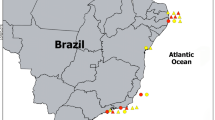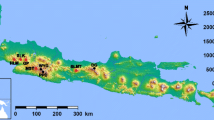Abstract
The present study compared population genetic structure of two northern hemisphere polychaetes, Neanthes virens (Sars, 1835) and Hediste diversicolor (O.F. Müller, 1776), with different life-history traits. N. virens has a pelagic larval phase that may last as long as 9 days, while H. diversicolor broods its offspring. It was predicted that N. virens populations, especially over relatively short geographic distances, would be more genetically similar than H. diversicolor populations. Sequence data were obtained for two mitochondrial genes, cytochrome c oxidase I (COI) and cytochrome b (cyt b). The COI gene showed no variation in 16 N. virens individuals from 12 locations, and it was not examined in H. diversicolor. The nucleotide sequence of the cyt b gene was examined in 93 N. virens individuals collected in 1992, 1999, and 2000 from 12 localities throughout its range (North America, Europe, Japan) and from 33 H. diversicolor individuals collected in 1999 and 2001 from one locality in eastern Canada and two localities in France (Roscoff and Marseille). In N. virens, one cyt b haplotype was shared by 89% (83 out of 93) and only two other haplotypes were found. Significant population structure was observed in H. diversicolor. In the 33 sequences compared, 18.9% of sites were polymorphic and 12 haplotypes were identified. There were two haplotypes in the Canadian population, three in the Marseille samples, and seven in the Roscoff samples, and no haplotype was found in common between any two sites. These results show that widely separated H. diversicolor populations are strongly differentiated at the cyt b locus. The most plausible interpretation for the low variation at the COI and cyt b loci in N. virens, and for the lack of variation at allozyme loci (based on an initial survey of a smaller subset of populations), is that this species has experienced a drastic bottleneck and that a few remaining lineages recolonized its entire range.

Similar content being viewed by others
References
Abbiati M, Maltagliati F (1992) Genetic population structure of Neanthes succinea (Polychaeta: Nereididae). J Mar Biol Assoc UK 72:511–517
Abbiati M, Maltagliati F (1996) Allozyme evidence of genetic differentiation between populations of Hediste diversicolor (Polychaeta: Nereididae) from the western Mediterranean. J Mar Biol Assoc UK 76:637–647
Arndt A, Smith J (1998) Genetic diversity and population structure in two species of sea cucumber: differing patterns according to mode of development. Mol Ecol 7:1053–1064
Avise JC (2000) Phylogeography: the history and formation of species. Harvard University Press, London
Ballard JWO, Kreitman M (1995) Is mitochondrial DNA a strictly neutral marker? Trends Ecol Evol 10:485–488
Bartels-Hardege HD, Zeeck E (1990) Reproductive behaviour of Nereis diversicolor (Annelida: Polychaeta). Mar Biol 106:409–412
Bass NB (1970) Aspects of the ecology, behavior and life history of the polychaete Nereis virens Sars. PhD thesis, Department of Biology, Queen Elizabeth College, University of London, London
Bass NB, Bradfield AE (1972) The life-cycle of the polychaete Nereis virens. J Mar Biol Assoc UK 52:701–726
Bastrop R, Röhner M, Sturmbauer C, Jürss K (1997) Where did Marenzelleria spp. (Polychaeta: Spionidae) in Europe come from? Aquat Ecol 31:119–136
Blier PU, Dufresne F, Burton RS (2001) Natural selection and the evolution of mtDNA-encoded peptides: evidence for intergenomic co-adaptation. Trends Genet 17:400–406
Boore JL, Brown WM (2000) Mitochondrial genomes of Galathealinum, Helobdella and Platynereis: sequence and gene arrangement comparisons indicate that Pogonophora is not a phylum and Annelida and Arthropoda are not sister taxa. Mol Biol Evol 17:87–106
Campbell AC, Nicholls J (1986) Guide de la faune et de la flore littorales des mers d'Europe. Delachaux et Niestlé, Paris
Chambers SJ, Garwood PR (1992) Polychaetes from Scottish waters, part 3: family Nereidae. National Museum of Scotland, Edinburgh
Chase MR, Etter RJ, Rex MA, Quattro JM (1998) Extraction and amplification of mitochondrial DNA from formalin-fixed deep-sea mollusks. Biotechniques 24:243–247
Collin R (2001) The effects of mode of development on phylogeography and population structure of North Atlantic Crepidula (Gastropoda: Calyptraeidae). Mol Ecol 10:2249–2262
Collins TM, Frazer K, Palmer AR, Vermeij GJ, Brown WM (1996) Evolutionary history of northern hemisphere Nucella (Gastropoda, Muricidae): molecular, morphological, ecological, and paleontological evidence. Evolution 50:2287–2304
Creaser EP, Clifford DA (1982) Life history studies of the sandworm, Nereis virens Sars, in the Sheepscot Estuary, Maine. Fish Bull (Wash DC) 80:735–743
Dahlgren TG, Lundberg J, Pleijel F, Sundber P (2000a) Morphological and molecular evidence of the phylogeny of nereidiform polychaetes (Annelida). J Zool Syst Evol Res 38:1–6
Dahlgren TG, Weinberg JR, Halanych KM (2000b) Phylogeography of the ocean quahog (Arctica islandica): influences of paleoclimate on genetic diversity and species range. Mar Biol 137:487–495
Dean D (1978) Migration of the sandworm Nereis virens during winter nights. Mar Biol 45:165–173
Desrosiers G, Caron A, Olivier M, Miron G (1994) Cycle de développement d'une population intertidale de Nereis virens (Polychaeta Nereidae) de l'estuaire maritime du Saint-Laurent. Oceanol Acta 17:683–695
Fauchald K (1977) The polychaete worms. Definitions and keys to the orders, families and genera. Nat Hist Mus Los Angel Cty Sci Ser 28:85–91
Fitzhugh K (1987) Phylogenetic relationships within the Nereididae (Polychaeta): implications at the subfamily level. Proc Biol Soc Wash 7:174–183
Foighil DÓ, Gaffney PM, Wilbur AE, Hilbish TJ (1998) Mitochondrial cytochrome oxidase I gene sequences support an Asian origin for the Portuguese oyster Crassostrea angulata. Mar Biol 131:497–503
Folmer O, Black M, Hoeh W, Lutz R, Vrijenhoek R (1994) DNA primers for amplification of mitochondrial cytochrome c oxidase subunit I from diverse metazoan invertebrates. Mol Mar Biol Biotechnol 3:294–299
Fong PP, Garthwaite RL (1994) Allozyme electrophoretic analysis of the Hediste limnicola–H. diversicolor–H. japonica species complex (Polychaeta: Nereididae). Mar Biol 118:463–470
Hateley JG, Grant A, Taylor SM, Jones NV (1992) Morphological and other evidence on the degree of genetic differentiation between populations of Nereis diversicolor. J Mar Biol Assoc UK 72:365–381
Hebert PDN, Beaton MJ (1989) Methodologies for allozyme analyses using cellulose acetate electrophoresis. Helena Laboratories, Beaumon, Tex.
Hellberg ME (1996) Dependence of gene flow on geographic distance in two solitary corals with different larval dispersal capabilities. Evolution 50:1167–1175
Hewitt GM (1996) Some genetic consequences of ice ages, and their role in divergence and speciation. Biol J Linn Soc 58:247–276
Khlebovich VV, Komendantov AY, Shklyarevich GA (1980) Validity of Nereis virens, N. grandis and N. brandti (Annelida, Polychaeta) and variations in the number of their paragnaths. Zool Zh 59:1617–1624
Knowlton N (2000) Molecular genetic analyses of species boundaries in the sea. Hydrobiologia 420:73–90
Kyle CJ, Boulding EG (2000) Comparative population genetic structure of marine gastropods (Littorina spp.) with and without pelagic larval dispersal. Mar Biol 137:835–845
Ladoukakis ED, Zouros E (2001) Direct evidence for homologous recombination in mussel (Mytilus galloprovincialis) mitochondrial DNA. Mol Biol Evol 18:1168–1175
Li JJ, Liao XH, Yang H (2000) Molecular characterization of a parasitic tapeworm (Ligula) based on DNA sequences from formalin-fixed specimens. Biochem Genet 38:309–322
Maddison WP, Maddison DR (1992) MacClade version 3.0. Sinauer, Sunderland, Mass.
Maltagliati F, Camilli L, Lardicci C, Castelli A (2001) Evidence for morphological and genetic divergence in Perinereis cultrifera (Polychaeta: Nereididae) from two habitat types at Elba Island. J Mar Biol Assoc UK 81:411–414
Maruyama T, Birky CW (1991) Effects of periodic selection on gene diversity in organelle genomes and other systems without recombination. Genetics 127:449–451
Nei M (1972) Genetic distance between populations. Am Nat 106:283–292
Nei M (1978) Estimation of average genetic heterozygosity and genetic distance from a small number of individuals. Genetics 23:341–369
Nei M (1987) Molecular evolutionary genetics. Columbia University Press, New York
Nielsen AM, Eriksen NT, Iversen JJL, Riisgard HU (1995) Feeding, growth and respiration in the polychaetes Nereis diversicolor (facultative filter-feeder) and N. virens (omnivorous) a comparative study. Mar Ecol Prog Ser 125:149–158
Olive PJW (1994) Polychaeta as a world resource: a review of pattern of exploitation as sea angling baits and the potential for aquaculture based production. Mem Mus Natl Hist Nat (Fr) 162:603–610
Palumbi SR, Kessing BD (1991) Population biology of the trans-Arctic interchange: mtDNA sequence similarity between Pacific and Atlantic sea urchins. Evolution 45:1790–1805
Patti FP, Gambi MC (2001) Phylogeography of the invasive polychaete Sabella spallanzanii (Sabellidae) based on the nucleotide sequence of internal transcribed spacer 2 (ITS2) of nuclear rDNA. Mar Ecol Prog Ser 215:169–177
Pettibone MH (1963) Marine polychaete worms of the New England region. 1. Aphroditidae through Trochochaetidae. Bull US Nat Mus 221:1–346
Rasmussen E (1973) Systematics and ecology of the Isefjord marine fauna (Denmark). Ophelia 11:1–495
Reise K, Gollasch S, Wolff WJ (1999) Introduced marine species of the North Sea coasts. Helgol Meeresunters 52:219–234
Rogers AR (1995) Genetic evidence for a Pleistocene population explosion. Evolution 49:608–615
Röhner M, Bastrop R, Jürss K (1997) Genetic differentiation in Hediste diversicolor (Polychaeta: Nereididae) for the North Sea and the Baltic Sea. Mar Biol 130:171–180
Romano SL, Palumbi SR (1997) Molecular evolution of a portion of the mitochondrial 16S ribosomal gene region in scleractinian corals. Mol Evol 45:397–411
Sato M (1999) Divergence of reproductive and developmental characteristics in Hediste (Polychaeta: Nereididae). Hydrobiologia 402:129–143
Sato M, Masuda Y (1997) Genetic differentiation in two sibling species of the brackish-water polychaete Hediste japonica complex (Nereididae). Mar Biol 130:163–170
Schneider S, Kueffer J, Roessli D, Excoffier L (2000) ARLEQUIN ver. 2.0: a software for population genetic data analysis. Genetics and Biometry Laboratory, University of Geneva, Geneva, Switzerland
Schön I, Butlin RK, Griffiths HI, Martens K (1998) Slow molecular evolution in an ancient asexual ostracod. Proc R Soc Lond B Biol Sci 265:235–242
Schroeder PC, Hermans CO (1975) Annelida: Polychaeta. In: Giese AC, Pearse JS (eds) Reproduction of marine invertebrates. Academic, London, pp 1–213
Schulze SR, Rice SA, Simon JL, Karl SA (2000) Evolution of poecilogony and the biogeography of North American populations of the polychaete Streblospio. Evolution 54:1247–1259
Slatkin M (1987) Gene flow and the geographic structure of natural populations. Science 236:787–792
Smith RI (1964) On the early development of Nereis diversicolor in different salinities. J Morph 114:437–464
Swofford D (1998) Phylogenetic analysis using parsimony (PAUP), version 4.0. Sinauer, Sunderland, Mass.
Thompson JD, Higgins DG, Gibson TJ (1994) CLUSTAL W: improving the sensitivity of progressive multiple sequence alignment through sequence weighting, position-specific gap penalties and weight matrix choice. Nucleic Acids Res 22:4673–4680
Vermeij GJ (1991) Anatomy of an invasion: the trans-Arctic interchange. Paleobiology 17:281–307
Wares JP (2001) Intraspecific variation and geographic isolation in Idotea balthica (Isopoda: Valvifera). J Crustac Biol 21:1007–1013
Wares JP, Cunningham CW (2001) Phylogeography and historical ecology of the North Atlantic intertidal. Evolution 55:2455–2469
Wilke T, Davis GM (2000) Infraspecific mitochondrial sequence diversity in Hydrobia ulvae and Hydrobia ventrosa (Hydrobiidae: Rissooidea: Gastropoda): do their different life histories affect biogeographic patterns and gene flow? Biol J Linn Soc 70:89–105
Wilson RS (1984) Neanthes (Polychaeta: Nereididae) from Victoria with description of two new species. Proc R Soc Vic 96:209–226
Wilson RS (1988) Synonymy of the genus Nectoneanthes Imajima, 1972, with Neanthes Kingberg, 1866 (Polychaeta: Nereididae). Proc Biol Soc Wash 101:4–10
Yokouchi K (1985) Reproduction and larval ecology of the sandworm Neanthes virens Sars from southern Hokkaido. Bull Plankton Soc Japan 32:1–13
Acknowledgements
We thank G. Miron, T. Miller, D. Schiedek, E. Herre, C. Lewis, I. Sokolova, S. Kojima, N. Rebscher, G. Stora, and A. Dorresteijn for sending specimens of N. virens and H. diversicolor. For helpful discussion and encouragement, we thank Dr. R. Cloutier. We would also like to thank Dr. C.W. Cunningham, Dr. J.P. Wares and two anonymous reviewers for comments on the manuscript. Financial support was made possible through NSERC grants to P. Blier, F. Dufresne, and G. Desrosiers. S. Breton was financially supported by an NSERC scholarship. All experiments complied with the current laws of Canada.
Author information
Authors and Affiliations
Corresponding author
Additional information
Communicated by J.P. Grassle, New Brunswick
Rights and permissions
About this article
Cite this article
Breton, S., Dufresne, F., Desrosiers, G. et al. Population structure of two northern hemisphere polychaetes, Neanthes virens and Hediste diversicolor (Nereididae), with different life-history traits. Marine Biology 142, 707–715 (2003). https://doi.org/10.1007/s00227-002-0992-5
Received:
Accepted:
Published:
Issue Date:
DOI: https://doi.org/10.1007/s00227-002-0992-5




